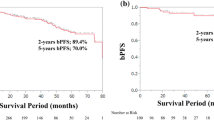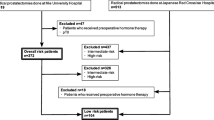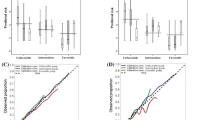Abstract
Purpose
We hypothesized that a relevant number of patients with clinically high-risk prostate cancer (PCA) indeed harbor overall favorable tumor characteristics (OFTC) (i.e., pT2a-c and Gleason score ≤3 + 4 = 7 and pN0/X) and that in these patients radical prostatectomy (RP) alone is most likely curative.
Methods
Between June 1, 1997, and October 31, 2011, 2,346 patients with biopsy-detected PCA underwent RP. According to D’Amico, 1,767 patients presented low-/intermediate-risk PCA, and 579 presented high-risk PCA. We compared the incidence of OFTC between low-/intermediate-risk and high-risk patients, and between high-risk patients with different risk factor constellations. Furthermore, overall survival (OS), cancer-specific survival (CSS) and biochemical progression-free survival (BFS) were calculated for low-/intermediate-risk and high-risk patients with and without OFTC.
Results
High-risk patients were less likely to harbor OFTC (17.3 vs. 58.2 %; p < 0.001). That means, however, that nearly one in five patients with clinically high-risk PCA indeed had OFTC. Particularly, the subgroup with PSA >20 ng/ml or cT2c-3 tumor as sole high-risk factor showed a considerable proportion of OFTC in 30.2 and 26.1 % of cases, respectively. While the entire high-risk group had shorter OS, CSS and BFS than the low-/intermediate-risk group, high-risk patients with OFTC had comparably good OS, CSS and BFS as low-/intermediate-risk patients with OFTC.
Conclusions
Nearly, one in five patients assumed to have high-risk PCA indeed had OFTC. Particularly, patients with PSA >20 ng/ml or cT2c-3 tumor as sole high-risk factor were often misclassified. However, these misclassified patients achieve excellent survival and have a reasonable chance of cure with RP alone.
Similar content being viewed by others
References
Gerber GS, Thisted RA, Chodak GW, Schroder FH, Frohmuller HG, Scardino PT, Paulson DF, Middleton AW Jr, Rukstalis DB, Smith JA Jr, Ohori M, Theiss M, Schellhammer PF (1997) Results of radical prostatectomy in men with locally advanced prostate cancer: multi-institutional pooled analysis. Eur Urol 32(4):385
Shariat SF, Karakiewicz PI, Roehrborn CG, Kattan MW (2008) An updated catalog of prostate cancer predictive tools. Cancer 113(11):3075
Cooperberg MR, Cowan J, Broering JM, Carroll PR (2008) High-risk prostate cancer in the United States, 1990-2007. World J Urol 26(3):211
Ward JF, Slezak JM, Blute ML, Bergstralh EJ, Zincke H (2005) Radical prostatectomy for clinically advanced (cT3) prostate cancer since the advent of prostate-specific antigen testing: 15-year outcome. BJU Int 95(6):751
Schreiber D, Rineer J, Sura S, Teper E, Nabhani T, Han P, Schwartz D, Choi K, Rotman M (2011) Radical prostatectomy for cT3-4 disease: an evaluation of the pathological outcomes and patterns of care for adjuvant radiation in a national cohort. BJU Int 108(3):360
Walz J, Joniau S, Chun FK, Isbarn H, Jeldres C, Yossepowitch O, Chao-Yu H, Klein EA, Scardino PT, Reuther A, Poppel HV, Graefen M, Huland H, Karakiewicz PI (2011) Pathological results and rates of treatment failure in high-risk prostate cancer patients after radical prostatectomy. BJU Int 107(5):765
Yossepowitch O, Eggener SE, Bianco FJ Jr, Carver BS, Serio A, Scardino PT, Eastham JA (2007) Radical prostatectomy for clinically localized, high risk prostate cancer: critical analysis of risk assessment methods. J Urol 178(2):493
Donohue JF, Bianco FJ Jr, Kuroiwa K, Vickers AJ, Wheeler TM, Scardino PT, Reuter VA, Eastham JA (2006) Poorly differentiated prostate cancer treated with radical prostatectomy: long-term outcome and incidence of pathological downgrading. J Urol 176(3):991
Epstein JI, Allsbrook WC Jr, Amin MB, Egevad LL, ISUP Grading Committee (2005) The 2005 international society of urological pathology (ISUP) consensus conference on Gleason grading of prostatic carcinoma. Am J Surg Pathol 29:1228
Epstein JI, Feng Z, Trock BJ, Pierorazio PM (2012) Upgrading and downgrading of prostate cancer from biopsy to radical prostatectomy: incidence and predictive factors using the modified Gleason grading system and factoring in tertiary grades. Eur Urol 61(5):1019
D’Amico AV, Whittington R, Malkowicz SB, Schultz D, Blank K, Broderick GA, Tomaszewski JE, Renshaw AA, Kaplan I, Beard CJ, Wein A (1998) Biochemical outcome after radical prostatectomy, external beam radiation therapy, or interstitial radiation therapy for clinically localized prostate cancer. JAMA 280(11):969
Walsh PC, Lepor H, Eggleston JC (1983) Radical prostatectomy with preservation of sexual function: anatomical and pathological considerations. Prostate 4(5):473
Patel VR, Thaly R, Shah K (2007) Robotic radical prostatectomy: outcomes of 500 cases. BJU Int 99(5):1109
Heidenreich A, Bastian PJ, Bellmunt J et al; Members of the European Association of Urology (EAU) Guidelines Office. Guidelines on Prostate Cancer. In: EAU Guidelines, edition presented at the 25th EAU Annual Congress, Barcelona 2010. EAU Guidelines Office, Arnhem, The Netherlands
Thompson I, Thrasher JB, Aus G, Burnett AL, Canby-Hagino ED, Cookson MS, D’Amico AV, Dmochowski RR, Eton DT, Forman JD, Goldenberg SL, Hernandez J, Higano CS, Kraus SR, Moul JW, Tangen CM (2007) AUA prostate cancer clinical guideline update panel. Guideline for the management of clinically localized prostate cancer: 2007 update. J Urol 177(6):2106
Mohler J, Bahnson RR, Boston B, Busby JE, D’Amico A, Eastham JA, Enke CA, George D, Horwitz EM, Huben RP, Kantoff P, Kawachi M, Kuettel M, Lange PH, Macvicar G, Plimack ER, Pow-Sang JM, Roach M 3rd, Rohren E, Roth BJ, Shrieve DC, Smith MR, Srinivas S, Twardowski P, Walsh PC (2010) NCCN clinical practice guidelines in oncology: prostate cancer. J Natl Compr Canc Netw 8(2):162
Boorjian SA, Karnes RJ, Viterbo R, Rangel LJ, Bergstralh EJ, Horwitz EM, Blute ML, Buyyounouski MK (2011) Long-term survival after radical prostatectomy versus external-beam radiotherapy for patients with high-risk prostate cancer. Cancer 117(13):2883
Abdollah F, Sun M, Schmitges J, Thuret R, Bianchi M, Shariat SF, Briganti A, Jeldres C, Perrotte P, Montorsi F, Karakiewicz PI (2012) Survival benefit of radical prostatectomy in patients with localized prostate cancer: estimations of the number needed to treat according to tumor and patient characteristics. J Urol 188(1):73
Yossepowitch O, Eggener SE, Serio AM, Carver BS, Bianco FJ Jr, Scardino PT, Eastham JA (2008) Secondary therapy, metastatic progression, and cancer-specific mortality in men with clinically high-risk prostate cancer treated with radical prostatectomy. Eur Urol 53(5):950
Lodde M, Harel F, Lacombe L, Fradet Y (2008) Substratification of high-risk localised prostate cancer treated by radical prostatectomy. World J Urol 26(3):225
Koupparis AJ, Grummet JP, Hurtado-Coll A, Bell RH, Buchan N, Goldenberg SL, Gleave ME (2011) Radical prostatectomy for high-risk clinically localized prostate cancer: a prospective single institution series. Can Urol Assoc J 5(6):E156
Ploussard G, Masson-Lecomte A, Beauval JB, Ouzzane A, Bonniol R, Buge F, Fadli S, Rouprêt M, Rebillard X, Gaschignard N, Pfister C, Villers A, Soulié M, Salomon L (2011) Prostate cancer committee of the French association of urology. Radical prostatectomy for high-risk prostate cancer defined by preoperative criteria: oncologic follow-up in national multicenter study in 813 patients and assessment of easy-to-use prognostic sub stratification. Urology 78(3):607
Boorjian SA, Karnes RJ, Rangel LJ, Bergstralh EJ, Blute ML (2008) Mayo clinic validation of the D’Amico risk group classification for predicting survival following radical prostatectomy. J Urol 179(4):1354
Nguyen PL, Chen MH, Catalona WJ, Moul JW, Sun L, D’Amico AV (2009) Predicting prostate cancer mortality among men with intermediate to high-risk disease and multiple unfavorable risk factors. Int J Radiat Oncol Biol Phys 73(3):659
Spahn M, Joniau S, Gontero P, Fieuws S, Marchioro G, Tombal B, Kneitz B, Hsu CY, Van Der Eeckt K, Bader P, Frohneberg D, Tizzani A, Van Poppel H (2010) Outcome predictors of radical prostatectomy in patients with prostate-specific antigen greater than 20 ng/ml: a European multi-institutional study of 712 patients. Eur Urol 58(1):1
Acknowledgments
We would like to thank Ms. M. Vanberg and Ms. A. Pailliart for their help with the data processing and Ms. H. Coleman for revision of the English manuscript.
Conflict of interest
The authors declare that they have no conflict of interest.
Ethical standards
The study was approved by local ethics committee and was performed in accordance with the 1964 Declaration of Helsinki and its later amendments. All patients gave their informed consent prior to their inclusion in the study.
Author information
Authors and Affiliations
Corresponding author
Rights and permissions
About this article
Cite this article
Musch, M., Pluemer, J., Roggenbuck, U. et al. Clinically high-risk prostate cancer patients comprise a relevant number of cancers with overall favorable tumor characteristics. World J Urol 33, 85–92 (2015). https://doi.org/10.1007/s00345-014-1274-9
Received:
Accepted:
Published:
Issue Date:
DOI: https://doi.org/10.1007/s00345-014-1274-9




